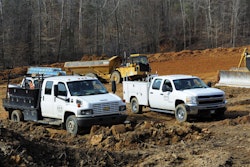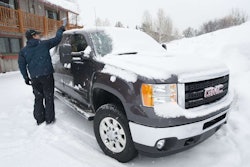FOG LIGHTS: Placement and Aiming Critical To Efficiency
by Peter D. duPre
Fog lights are a common factory upgrade on many pickups and SUVs.
A properly designed fog light delivers a wide and relatively short (not more than a 150 feet or so) beam pattern that is aimed low to increase road visibility near the vehicle during slow speed inclement weather driving.
The primary purpose of these auxiliary lights is to illuminate the road close to the vehicle and shine under the weather instead of reflecting light back into the driver’s eyes.
Since the purpose of the fog light is to help improve visibility when conditions are poor, a quality light will have a cut-off line along the top of the light beam that prevents the light from reflecting back into your eyes.
This effect, called backscatter, is caused when up angled light beams reflect off the moisture droplets in the fog (or from the snow, misty rain or dust), which is why high beams are totally useless under such conditions.
Also helping with the visibility is the choice of lens color; white, amber and yellow lenses work well with the human eye. Blue spectrum lights, such as many HID (high intensity discharge) lamps, are less effective in this situation.
FOG LIGHT PLACEMENT
As for fog light placement, they work best mounted in or on the bumper (10 to 24 inches above the road surface) and below the headlights, where their beam can cut just under that of the low-beam headlights.
The lights should be positioned closer together than the headlights (approximately 20-26 inches between them) and aimed below the center of the headlight beams.
The best way to aim the lights is to park the truck on a level surface 25 feet from a wall. Measure the distance between the center of the auxiliary light and the ground. Place a horizontal mark on the wall at that height.
Visual aim is made with the top of the fog light beam 4 inches below the lamp center at 25 feet with the lamp facing straight forward. Some adjustment may be necessary, depending upon the ride height of the truck. Also make sure that they are wired so that they operate either independently and/or in conjunction with the low beams.
Never wire fog lights into high beam headlamps or auxiliary driving lights as this can blind oncoming traffic. It can also be against state vehicle laws.
OTHER FOG LIGHT USES
According to Bruce W. Smith, editor of ProPickup, fog lights have other practical uses in the construction and landscaping trades.
In ProPickup’s auxiliary lights buying guide, Smith points out that when mounted on the rear bumper they make great backup lights and when installed higher up on a rack, the wide beam pattern makes for a serviceable work light.









